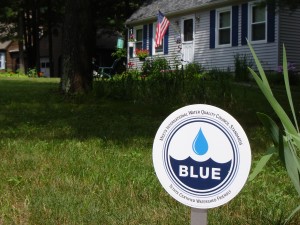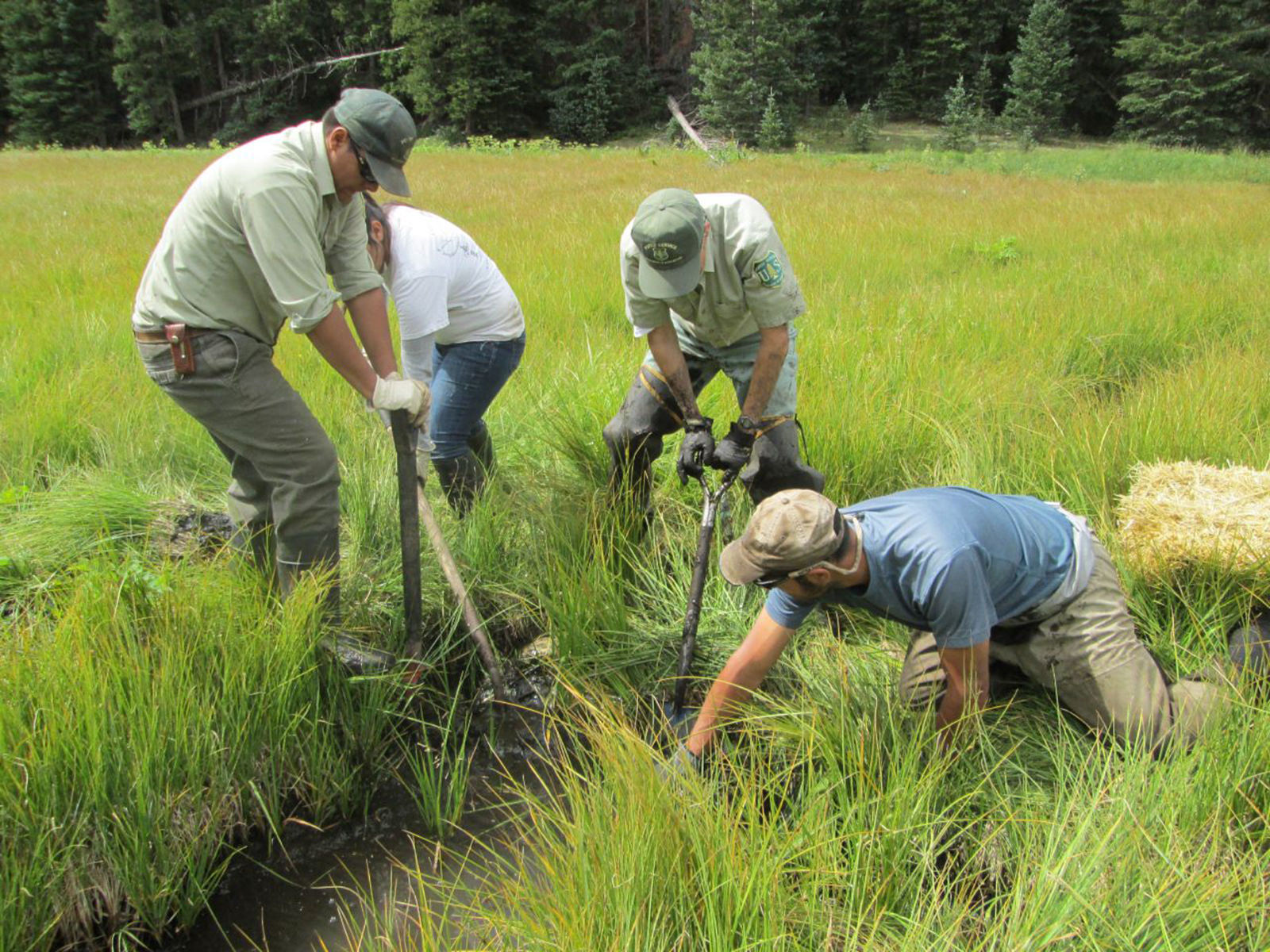
Incentive Types
1. Development incentives
2. Grants
3. Rebates/installation financing
4. Awards/recognition programs
5. Stormwater fee discounts
Incentive programs provide a way to increase the use of green infrastructure on private property. These programs can help cities implement stormwater controls on both new and existing developments not covered by stormwater requirements.
Cities can use incentive programs to target specific locations or issues, such as eliminating combined sewer overflows (CSOs), increasing groundwater recharge, enhancing drainage in certain neighborhoods, or improving downtown walkability and access to green space. Some programs offer stormwater fee reduction credits to schools for stormwater education, while others seek to eliminate pollution from electronic waste by providing a discount for household hazardous waste collection.
Incentive programs can serve as a mode of public outreach — providing an opportunity for cities to reach out to customers about stormwater, control measures, and maintenance. Online tools like Green Up DC enable property owners to share their projects and calculate their stormwater and energy-saving successes.
According to the U.S. Environmental Protection Agency (EPA), there are five main types of incentive programs.
1. Development incentives
Development incentives include expedited permitting, decreased fees, zoning upgrades, reduced stormwater requirements, and other benefits to developers who plan to use green infrastructure. Development incentives go beyond single-site improvements and can have large-scale impacts.
As part of the city’s Grey to Green Initiative, Portland, Ore., developed an Ecoroof Incentive program with the goal of establishing 17 ha (43 ac) of ecoroofs, which are essentially lightweight, low-maintenance green roofs.
Portland Mayor Sam Adams championed the Grey to Green Initiative and its ecoroof component. “This program has primarily been successful because of strong political support,” said Alice Coker, who administers the program and serves as environmental specialist for the Portland Bureau of Environmental Services (BES).
According to a BES report, there are more than 172 ecoroofs in Portland. Through the Ecoroof Initiative, the city has approved $1.9 million in projects, offering property owners reimbursements of $5 per ft2 of ecoroof. The roofs are expected to reduce runoff by 5168 m3/ha (552,600 gal/ac).
The program is open to both new and retrofit properties larger than 11 m2 (120 ft²). Portland has worked to make the application process simple and easily accessible. Structural calculations and operations and maintenance plans are included in the building permit process. The city also requests detailed project reports that include lessons learned and cost data.
The City of Portland conducts other incentive programs, including the Clean River Rewards program, which offers a discount in stormwater utility fees to private-property owners who manage stormwater onsite.
2. Grants
Grants to private-property owners and community groups can also encourage green infrastructure. Cities can provide money to private entities directly for green infrastructure practices or promote them indirectly through low-impact development competitions, outreach, and other avenues.
The Green Improvement Fund in Onondaga County, N.Y., provides grant funding to commercial properties that install green infrastructure practices in specific sewer districts. The program is part of a larger CSO abatement program that seeks to eliminate 946,353 m3 (250 million gal) of CSOs by 2018.
So far, 28 projects that capture approximately 41,640 m3 (11 million gal) of stormwater have been completed. “You can build momentum quickly, even if you are just starting with a few projects,” Millea said.
In Onondaga County, engineering firms can implement their choice of green infrastructure techniques, but grants are determined by the amount of stormwater captured. To date, the county has spent about $3.4 million. “We are hitting our metrics from a cost-effectiveness standpoint,” Millea said.
Onondaga County also ensures that a project will provide measurable stormwater capture resulting in CSO reduction. In addition to initial and follow-up inspections, property owners are contractually obligated to provide maintenance under a 10-year agreement. Follow-up inspections range from checking vacuum records on pervious pavement to visual inspections for litter and debris in rain gardens.
According to Millea, another success factor is a sound and transparent process that garners respect for being fair. “You need a rigorous review of projects and a strong rationale for giving out public dollars to private enterprise,” he said.
3. Rebates and installation financing

A rain garden that is one of 800 practices approved under the RainScapes Rewards Program (Montgomery County, Md.)
Photo Credit: Montgomery County Department of Environmental Protection RainScapes Program
Rebates and installation financing include funding, tax credits, or reimbursements to property owners who install green infrastructure. These programs typically offer a list of specific practices, such as installation of cisterns, permeable pavement, or green roofs.
In Maryland, Montgomery County coordinates RainScapes Rewards, a rebate program used to meet part of its municipal separate storm sewer system (MS4) permit goals. The county provides rebates based on the amount of runoff captured. Residential properties are capped at $2500, and institutional parcels (homeowner association [HOA], commercial, or nonprofit/church properties) are capped at $10,000.
The program started in spring 2008, and now data on more than 800 approved RainScapes projects are stored in an internal database. Through these practices, Montgomery County has been able to treat runoff from about 4 to 5 ha (11 to 12 ac) of impervious area.
One of the county’s most effective strategies for increasing participation in RainScapes Rewards has been a training program for professionals, such as landscape architects and designers, nursery staff, paving contractors, and rain-barrel vendors. “The difference in participation was significant after we started training professionals,” said RainScapes Rewards Coordinator Ann English.
Similar to other programs, Montgomery County prescreens applicants, performs final inspections, and requires a maintenance agreement. Both commercial and residential properties are eligible for rebates, but most commercial applications are for private schools and HOA common areas. “We have not had a lot of interest from purely commercial properties at this point,” English said. However, the county is planning to reach out to property managers to determine participation barriers.
“The program is still constantly evolving,” English said. Montgomery County is working to make the program more interactive so participants and staff can enter data through a Web-based portal and update the database in real-time.
English recommends considering all possible metrics to track at the outset of the program. “Make the metrics uniform for all project types, so you can do apples-to-apples comparisons between the project benefits,” she said.
4. Awards and recognition programs

BLUE-Certified homeowners receive a lawn sign indicating that their property is watershed-friendly (Colchester, Vt.).
Photo credit: Lake Champlain International
Awards and recognition programs reward innovation and increase awareness of green infrastructure projects by the public and decision-makers. One example is the Lake Champlain International (LCI) BLUE® certification for watershed-friendly homes.
What is the motivation for homeowners? Green infrastructure practices increase property values. According to the University of Louisville, trees alone increase home values by 5% to 20%. Certified homeowners receive a BLUE certification lawn sign and the satisfaction of improving local water quality. LCI is also working with cities to implement a stormwater utility discount for certified homeowners.
As a first step, homeowners work with an evaluator on a checklist of behavioral and physical practices they should adopt to become BLUE-certified. Behavioral changes include using phosphorus-free detergent and disposing of pharmaceuticals properly, for example. Physical practices include runoff prevention features, such as redirected downspouts, rain gardens, and rain barrels. For features requiring installation, LCI provides funding to help offset the cost of the project. Once completed, an evaluator returns to ensure proper installation, then certifies the homeowner, who is required to sign a legally binding 3-year maintenance agreement. Homeowners also agree to an annual audit, and at 3 years, the home is evaluated for recertification.
So far, the program has certified nearly 100 properties. “Getting out in the streets and knocking on doors and going to public-forum meetings are the best ways to get people involved,” Saxton said. “Once the community starts to recognize what you are doing, there are cascading effects, and more homeowners start participating.”
The BLUE program is owned by Tethys Environmental and is available to nonprofits, municipalities, and private companies nationwide. This program can also satisfy the public education and outreach and public participation/involvement minimum control measures of EPA’s MS4 permit.
5. Stormwater fee discounts
Stormwater fee discounts are the most common type of incentive program. Reducing runoff from private property decreases burdens on the city stormwater system. A reduction in service demands can be reflected to property owners through fee discounts.
In Philadelphia, for example, apartment buildings faced high stormwater bills due to high rates of drinking water consumption. Meanwhile, commercial parking lots, which generate significant runoff, often paid nothing because they did not consume drinking water.
Philadelphia’s new stormwater fee system is based on impervious area as determined by geographic information systems (GIS). Under the new system, “the polluter pays and properties can expect their charges to reflect their relative contribution to the problem,” EPA said.
Stormwater fee discounts are generally given based on decreases in impervious surfaces, installation of particular controls, or by volume or pollutant-reduction performance.
Philadelphia offers a stormwater fee discount up to 80% of the impervious area charge or gross area charge, or both for customers who reduce impervious cover with green infrastructure practices. If retrofitted with green infrastructure, the Philadelphia Water Department will recalculate that property’s stormwater fee.
“By creating simple financial incentives for developers to reduce site imperviousness, the city is getting the development community to build green infrastructure projects that will help achieve citywide goals for watershed improvements, flood mitigation and community amenities,” EPA said. (Read more, pg. 49)














Why can’t I email to myself?
Next to the building where I live a 15 acre development is in the planning and it is majorly void of green space. Because my balcony will meet within 15 feet of a 4 story building I am looking for any support to pass on to my city council in reference to green space, storm run off and gardens with plants that will defuse pollution and possibly make them a star city in the green space consideration for environmental sustainability in new developments. The article seems to have excellent information of the substance I am seeking for my city of St.Anthony, Mn. 55418.
Thank you for any assistance.
Yvonne Meyer
I have 8 # culverts dumping runoff water onto my property of 7.71 acres two of which are raw sewage . Located at 592 river road in the city of Decatur , TN 37322 flooding is egregious . The flooding is preventing me form using my land as I see fit , which is guaranteed us by the 14 th and 5 th amendments in the constitution .The city will not help me diverting the water around the property onto their easements that encompasses the property . Why should I have to higher an attorney when I am protected by the USA constitution ? WILLIAM H RICKMAN e-mail rickmaster@comcast.net phone 804-930-6868 . Open for suggestions